February 24th – Anniversary of the Republic of Estonia
Our best wishes to Estonia!
Our best wishes to Estonia!
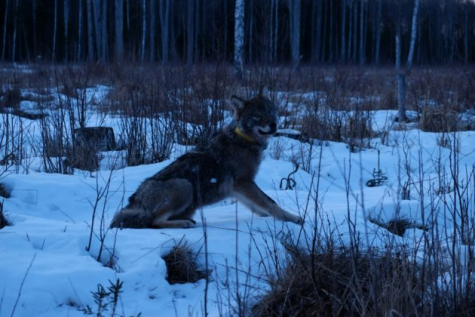
At dusk the young wolf was helped back to the forest by hunters of the Pärnumaa Hunters’ Association and wolf investigator Marko Kübarsepp.
Photos: Eero Nõmm and Marko Kübarsepp
Estonian text posted by the Animal of the Year Team 24.02.2019
English translation Liis
Moving along beaver paths you may also meet other semi-aquatic animals. Most frequently the American mink can be seen.
Posted by the Animal of the Year Team 23.02.2019
Compared to the beaver the mink is a quite small creature. A nature observer novice may even wonder whether they see an otter or a mink. The mink is small, body length stops at 30-47 cm, the otter is half as much longer than the mink – body length 60-90 centimetres. As always with semi-aquatic animals minks and otters move out of water too, splashing at the verge of the ice or along the bank of a water body. You will see their respective tails then and determine whom you have to do with from that. The tail of the mink is beautiful and fluffy! The otter has a rather stick-like tail.
Text and illustrations Tiit Hunt, www.rmk.ee
English translation Liis
Estonian text posted 21.02.2019
The antler-shedding period of the red deer is still ahead; from previous years we know that even a powerful old stag sheds its antlers in the last week but one in February at the earliest.
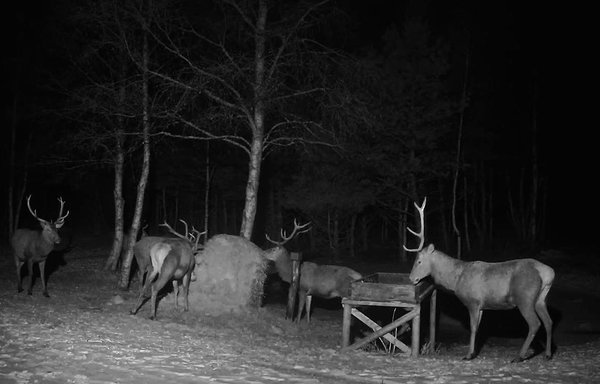
Images: Tiia and Ain Panek
English translation Liis
In East Virumaa there is enough snow
Roe deer Metskits or kaber Capreolus capreolus
How and why do wild animals find their way into a home garden?
We can only guess, and there may be quite a number of different reasons but probably that household has no dog, the entrance to the yard is not closed with a gate and the animal felt secure for almost a week.
Text and webcam records Tiit Hunt, www.rmk.ee
English translation Liis
Estonian text posted 13.02.2019
MatsaluBay has frozen to a large open field and the paths of the jackals now in winter seem to run in wider sweeps, the sea is no longer an obstacle that keeps the animals firmly on the shore areas. The tracks of two jackals have been observed running across the bay.
Video recorded by Ahto Täpsi
English translation Liis
Small spring-fed streams flow in the hilly landscape where the beaver family is active and has its winter life
Beaver Kobras ehk piiber Castor fiber
There is soon cause to discuss the life of beavers – at the end of February their heat period starts.
When a beaver dives, a line of small air bubbles remains along its path. The fur of the animal is not wetted but for this it has to take care. Its fur consists of an extremely dense undercoat through which water cannot penetrate and rougher and longer upper hairs.
Web camera image IceAge, LK foorumist
Photo Kaido Haagen, www.kaidohaagen.com
English translation Liis
Stickleback shoal at the trout spawning place. Such a great number has not been seen earlier
Ninespine stickleback Luukarits Pungitius pungitius
Linnuvaatleja, www.linnuvaatleja.ee
English translation Liis
The Nordic winter is a harsh challenge not only for birds but also for mammals. Some bats fly to spend winter in warmer parts of Europe, others stay to hibernate at home. Bears, badgers, raccoon dogs, dormice, birch mice and hedgehogs also hibernate. Many quadrupeds however remain to face hunger and cold and so do not even shy off from the dangerous proximity of humans when searching for food and shelter. Smaller mammals – for instance some rodents - also visit the birdfeeders.
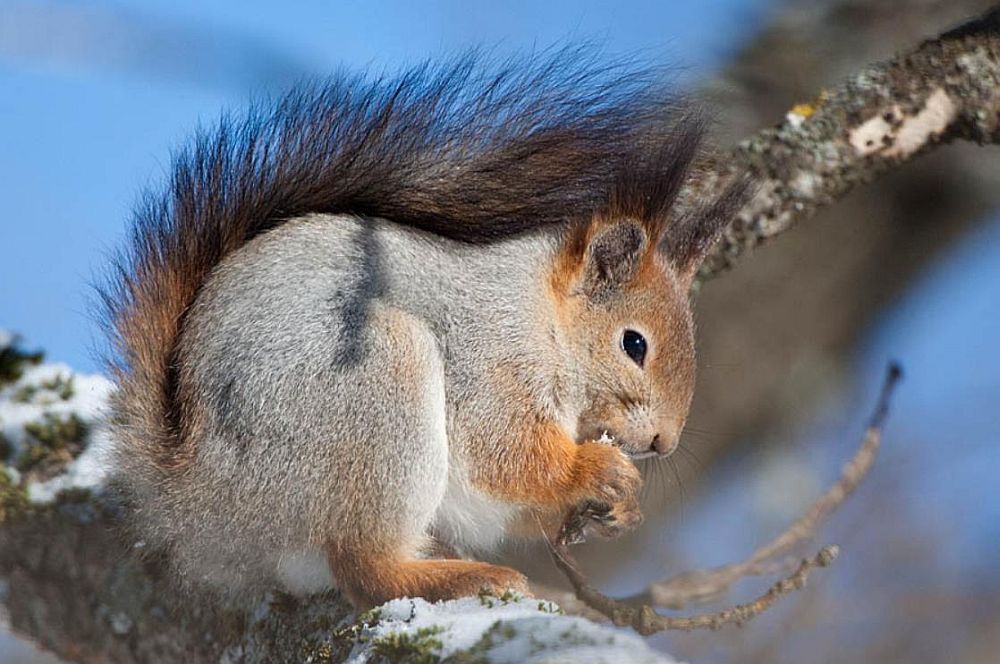
The beaver male and female set up a family with strong bonds and the union lasts if possible throughout life. If one partner perishes (the beaver is the prey of many predators and it should be remembered that it is also a quarry of hunters) a new partner is sometimes found, to carry on the species
Video: Tarmo Mikussaar
Photos Peep Käspre and Vello Keppart
English translation Liis
Estonian text posted 06.02.2019
Brown hare; European hare Halljänes Lepus europaeus
The season has arrived when the brown hares begin to take an interest in the fruit trees in gardens. The thaw created a new and load-bearing layer on the snow that is covered by a fresh snow layer – all traces of activities nicely visible.
Video Ahto Täpsi
English translation Liis
Estonian text posted 03.02.2019
Screencap from webcam Biker, LK forum
English translation Liis
Estonian text posted 04.02.2019
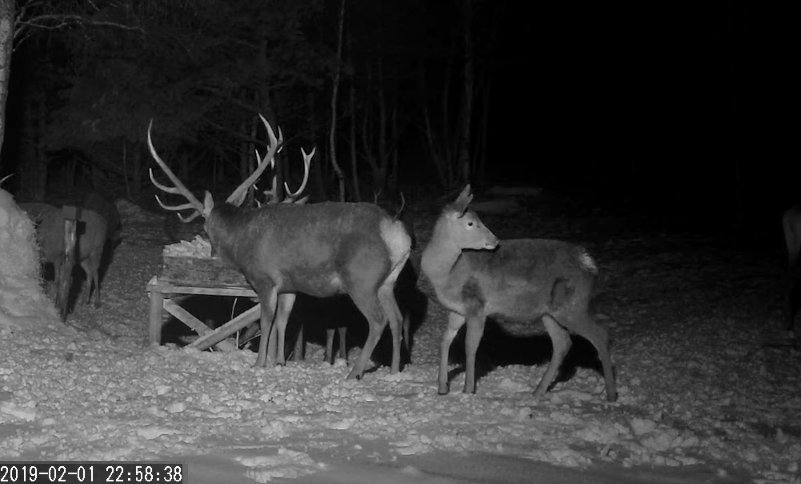
Red deer Punahirv Cervus elaphus
As was expected the female deer have started moving around at the feeding ground. We have just not had any good images showing both sexes before.
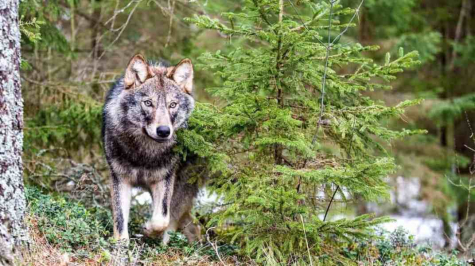
For forest owners , the control of wild herbivore populations by predators is helpful.
Photo: Sergei Gorškov, https://wilderness-society.org
Estonian text posted by the Team of the Animal of the Year 03.02.2019
English translation Google Translate
The utility of large carnivores for the entire ecosystem is quite clear to all. For humans, predators are generally still considered a problem. However, a study published by Australian and US scientists in Nature Ecology & Evolution in 2018 was specifically dedicated to pointing out the benefits that humans receive from the presence of wild predators.
Video recorded and saved by Ahto Täpsi
English translation Liis
Estonian text posted 02.02.2019
Roe deer Metskits or kaber Capreolus capreolus
The snow cover is thick and has become layered from the intermediate thaws; layers of ice have remained in the snow. The snowfall and thaw at the weekend do not make the life of roe deer easier. The ice layers already damage their legs. It takes time and energy to get to the food and a sleeping place for the night must be dug out down to the ground – otherwise the deer may get pneumonia.
Screencap from webcam IceAge, LK forum
Illustrations from Wikipedia
English translation Liis
Estonian text posted 23.01.2019
In the spawning area we meet spawners as well as their ”satellites”
Members of the LK forum have been interested in what small animals we can see in action in such waters. The information below is provided by Henn Timm from the Estonian University of Life Sciences:
"In the upper reaches of rivers and streams where the flow is rapid and the water is cold there is almost no plankton. The zoobenthos (the animal fauna of the bottom) is dominated by crenobiotic species (invertebrate aquatic organisms living in cold spring waters), for instance unicellular species, crustaceans, insect larvae, leeches, snails … Typical fish species are river trouts and graylings “.
Copyright 2025 · Looduskalender
Designed by Zymphonies
We also use analytics & advertising services. To opt-out click for more information.